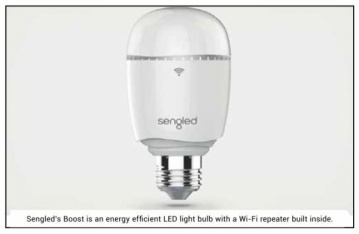
The consumer landscape for light bulbs in the U.S. changed drastically in 2007 when Congress passed the Energy Independence & Security Act mandating, among other things, that household light bulbs in the 40-100 watt range needed to up their energy efficiency standards by at least 25 percent. This change effectively took the tried-and-true yet inefficient incandescent bulbs that lit up the entire 20th century out of the marketplace - and compact fluorescent (CFL) bulbs, long the first choice for those looking to save on electricity usage, rushed in to take their place. CFLs on average use about 75 percent less energy to generate the same amount of light as conventional incandescents - consumers switching their whole houses over to CFLs could save hundreds of dollars a year on their electricity bills.
While CFLs were a giant step forward in energy savings and reduced the carbon footprint of lighting up our world, they contain trace amounts of mercury, a potent neurotoxin, that is sent airborne when they break. While CFLs still dominate domestic light bulb sales, their time on top may be short-lived given the development of even more efficient bulbs based on mercury-free light emitting diodes (LEDs). An LED uses around 90 percent less electricity than an equivalent incandescent bulb and almost 60 percent less than a CFL to generate an equivalent amount of light. While LEDs do contain trace amounts of lead and arsenic, they are a lot less likely to break than CFLs and last a lot longer.
The surge in popularity of LED bulbs has led to lots of innovation in the lighting field. For example, Lighting Science is using LED lights developed for NASA to help astronauts sleep better in its new line of bulbs for the rest of us to use in our homes. Meanwhile, Sengled integrates consumer electronics (bluetooth speakers, home security cams, wi-fi repeaters, etc.) with energysaving LED lighting in order to reduce clutter while expanding smart home capabilities. Their Element bulbs can be controlled via an app to dim or turn off at certain predetermined times, and can adjust the intensity and warmth of the lighting tone depending on the time of day or other user preferences. LEDs have busted out of the bulb, too, for some interesting new lighting applications: An LED wallpaper emits a “glow” in variable color casts; and LED “virtual sky panels” can replace office ceiling panels and give workers the sense of being outside in the sun.
But just when we were all starting to get used to these changes, incandescents are on the comeback. GE’s new energy efficient incandescents are 28 percent more efficient than their predecessors and thus just squeak past the Energy Independence & Security Act cut-off. Likewise, Newcandescent bulbs use krylon gas to extend their lifespan five to 10 times longer than traditional incandescents. And researchers from MIT and Purdue have collaborated on a new type of incandescent bulb that captures the waste heat from the conventional internal filament and recycles it into more light, upping the efficiency into the range of CFLs and LEDs. Given all the energy-efficient choices, If you haven’t switched out the old incandescents around the house, now might be the time.
CONTACTS: Lighting Science, www.lsgc.com; Sengled, www.sengled.com; GE Lighting, www. gelighting.com; Newcandescent Light Bulbs, www. newcandescent.com; “A Nanophotonic Comeback for Incandescent Bulbs,” http://news.mit. edu/2016/nanophotonic-incandescent-lightbulbs-0111.
EarthTalk® is produced by Roddy Scheer & Doug Moss and is a registered trademark of the nonprofit Earth Action Network. To donate, visit www.earthtalk.org. Send questions to: question@earthtalk.org.
























